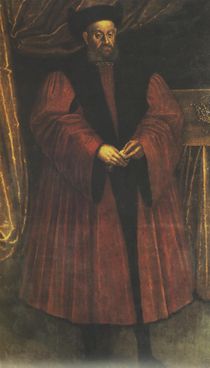Sigismund I the Old
| Sigismund I the Old | |
|---|---|
 |
|
|
|
|
| Reign | 1506 - 1548 |
| Coronation | 24 January 1507 in Wawel Cathedral, Kraków |
| Predecessor | Alexander Jagiellon |
| Successor | Sigismund II Augustus |
|
|
|
| Reign | 1506 - 1548 |
| Coronation | 24 January 1507 in Wawel Cathedral, Kraków |
| Predecessor | Alexander Jagiellon |
| Successor | Sigismund II Augustus |
| Spouses | Barbara Zápolya Bona Sforza |
| Issue | |
| Hedwig, Electress of Bradenburg Isabella, Queen of Hungary Sigismund II Augustus Sophia, Duchess of Brunswick-Lüneburg Anna I of Poland Catherine, Queen of Sweden |
|
| Dynasty | Jagiellon Gediminid |
| Father | Casimir IV of Poland |
| Mother | Elisabeth of Austria |
| Born | 1 January 1467 Kozienice, Poland |
| Died | 1 April 1548 (aged 81) Kraków, Poland |
| Burial | 7 July 1548 Wawel Cathedral, Kraków |
| Signature | |

Sigismund I of Poland (Polish: Zygmunt I Stary; Lithuanian: Žygimantas II Senasis) (1 January 1467 – 1 April 1548), of the Jagiellon dynasty, reigned as King of Poland and also as the Grand Duke of Lithuania from 1506 until 1548. Earlier, Sigismund had been invested as Duke of Silesia.
Contents |
Biography

The son of King Casimir IV Jagiellon and Elisabeth of Austria, Sigismund followed his brothers John I of Poland and Alexander I of Poland to the Polish throne. Their elder brother Ladislaus II of Hungary and Bohemia became king of Hungary and Bohemia. Sigismund was christened as the namesake of his mother's maternal grandfather, Holy Roman Emperor Sigismund, who had died in 1437.
Sigismund faced the challenge of consolidating internal power in order to face external threats to the country. During Alexander's reign, the law Nihil novi had been instituted, which forbade Kings of Poland from enacting laws without the consent of the Sejm. This proved crippling to Sigismund's dealings with the szlachta and magnates.
Despite this Achilles heel, he established (1527) a conscription army and the bureaucracy needed to finance it.
After the death of Janusz III of Masovia in 1526, he succeeded in annexing the Duchy of Masovia.
Intermittently at war with Vasily III of Muscovy, starting in 1507 (before his army was fully under his command), 1514 marked the fall of Smolensk (under Lithuanian domination) to the Muscovite forces (which lent force to his arguments for the necessity of a standing army). Those conflicts formed part of the Muscovite wars. 1515 he entered an alliance with the Holy Roman Emperor Maximilian I.
In return for Maximilian lending weight to the provisions of the Second Peace of Thorn (1466), Sigismund consented to the marriage of the children of Vladislaus II of Bohemia and Hungary, his brother, to the grandchildren of Maximilian. Through this double marriage contract, Bohemia and Hungary passed to the House of Habsburg in 1526, on the death of Sigismund's nephew, Louis II.
Worried about the growing ties between the Habsburgs and Russia, in 1524 Sigismund signed a Franco-Polish alliance with king Francis I of France.[1] The agreement fell through however when Francis I was vanquished by Charles V at the Battle of Pavia in 1525.[2]
The Polish wars against the Teutonic Knights ended in 1525, when Albert, Duke of Prussia, their marshal (and Sigismund's nephew), converted to Lutheranism, secularized the order, and paid homage to Sigismund. In return, he was given the domains of the Order, as the First Duke of Prussia. This was called the Prussian Homage.

Sigismund's eldest daughter Hedwig (1513–1573) married Joachim II Hector, Elector of Brandenburg.
In other matters of policy, Sigismund sought peaceful coexistence with the Khanate of Crimea, but was unable to completely end border skirmishes. Sigismund was interested in Renaissance humanism and the revival of classical antiquity. He and his third consort, Bona Sforza, daughter of Gian Galeazzo Sforza of Milan, were both patrons of Renaissance culture, which under them began to flourish in Poland and in the Grand Duchy of Lithuania.
On Sigismund's death, his son Sigismund II August became the last Jagiellon king of Poland and Grand Duke of Lithuania.
Sigismund I was a member of the Order of the Golden Fleece.
Marriages and issue
In 1512, Sigismund married a Hungarian noblewoman named Barbara Zápolya, with whom he had two daughters:
- Electress Hedwig of Brandenburg (1513–1573)
- Anna
Barbara died in 1515.
In 1517, Sigismund married Bona Sforza, with whom he had:
- Queen Isabella of Hungary
- Sigismund II of Poland
- Sophia, Duchess of Brunswick-Lüneburg
- Anna I of Poland
- Queen Catherine of Sweden
- Wojciech Olbracht
By his mistress, Katarzyna Telniczenka (d.1528), he also fathered three children out of wedlock:[3]
- Jan (8 January 1499—18 February 1538), Bishop of Wilen (1519) and of Posen 1536
- Regina (1500/01—20 May 1526), wed ca 20 October 1518 Hieronim von Szafraniec, Starost of Teschen (d.1556/59)
- Katharina (Katarzyna) (1503—before 9 September 1548) wed after 1522 George II Count von Montfort in Pfannberg (d.1544)
Gallery
 thumb|right|Sigismund I wearing the Crown of Bolesław the Brave |
 Coin with likeness of Sigismund I the Old |
Polish white eagle with Sigismund`s monogram |
Ancestry
Heritage
|
King Sigismund I and bishop Tomicki kneeling before St. Stanisław, a leaf form the Hours of Sigismund I by Stanisław Samostrzelnik |
 The Sigismund's Chapel of the Wawel Cathedral built for Sigismund I between 1517-1533 by Bartolommeo Berrecci |
 Wawel Castle courtyard constructed between 1516-1536 on the order of King Sigismund I the Old |
.jpg) Castle in Piotrków Trybunalski was built for the King between 1512-1519 by Master Benedykt of Sandomierz |
See also
- History of Poland (1385-1569)
- Zygmunt (bell)
Notes
| Preceded by Alexander Jagiellon |
Grand Duke of Lithuania 1506–1548 |
Succeeded by Sigismund II Augustus |
| King of Poland 1506–1548 |
|
|||||||||||
|
||||||||||||||||||||||||||